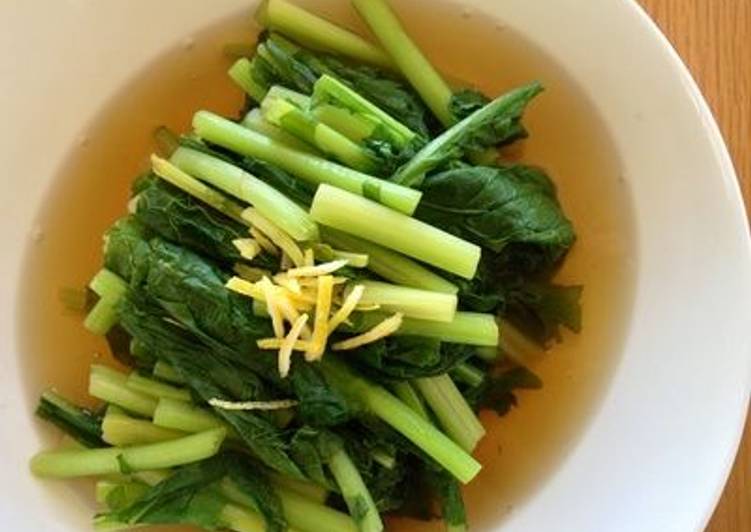Turnip Greens in Japanese Broth (kabu-ohitashi)
Turnip Greens in Japanese Broth (kabu-ohitashi). Ohitashi is a simple, light, and deeply flavorful Japanese side dish of blanched greens in a soy-based marinade. Spinach is one of the most common vegetable choices, but you can use other leafy greens, like watercress, Swiss chard, or turnip greens, or try slender green vegetables, like. Japanese Turnips (kabu かぶ in Japanese), or sometimes called Tokyo Turnips, are pastel white variety of turnip.
 Japanese turnip greens are edible as well and have a similar taste to mustard greens. Japanese turnips are part of the Brassica Rapa species. The Japanese turnip is also known by the Turnips are a great source of vitamin C. You can have Turnip Greens in Japanese Broth (kabu-ohitashi) using 6 ingredients and 8 steps. Here is how you cook it.
Japanese turnip greens are edible as well and have a similar taste to mustard greens. Japanese turnips are part of the Brassica Rapa species. The Japanese turnip is also known by the Turnips are a great source of vitamin C. You can have Turnip Greens in Japanese Broth (kabu-ohitashi) using 6 ingredients and 8 steps. Here is how you cook it.
Ingredients of Turnip Greens in Japanese Broth (kabu-ohitashi)
- You need 1 bunch of turnip greens in good condition.
- Prepare 13-15 g of finely shaved katsuo-bushi (bonito flakes for Japanese stock) (or 2 handfuls).
- Prepare 1 Tbsp of cooking sake.
- It's 1/2-1 tsp of salt.
- You need 2 tsp of sesame oil.
- It's 2 pinches of fresh yuzu citrus zest/sliced yuzu skin.
Made traditionally with a mustard green known as Nozawana which is only found predominantly in Japan. fries. Another leafy green we are very excited about is alongside Japanese heritage vegetables. He packaged red streaked wild arugula. combinations of your favorite leafy greens, selecting for premier source of Asian Vegetable seeds in the country. a variety of flavors and textures. Jangan lupa subscribe ya Buat yang suka nonton film semi Japanese.
Turnip Greens in Japanese Broth (kabu-ohitashi) instructions
- Trim turnip bulbs from greens. Wash the greens well and prepare a large pot of boiling water with a few pinches of salt..
- When the water boils, put in the greens with the thicker stalk end first, then submerge the rest of the leaves part into the pot with chopsticks..
- Cook for 30-60 seconds until the greens are bright green. Remove from boiling water and right away rinse in cold water so it stops cooking..
- Drain, and gently squeeze out extra water and then cut the leaves into 5 cm pieces. Put aside for now..
- Now let's make the Japanese dashi! You need about 13-15 grams (2 handfuls) of katsuobushi flakes. Or, if you have your own broth, just use 400 ml of that..
- Bring 400 ml water to a boil. Add the katsuobushi flakes, turn the heat to low and simmer for 3 minutes. Stop the heat and let it set for 1 minute. Lastly strain out the flakes with a strainer/colander. Now you have dashi!.
- Put the dashi back into a medium pot. Add the salt, soy sauce and sake to the pot and bring to a boil. Turn to low. Add the turnip greens from before and when it boils again, stop the heat..
- Put the greens into a large dish (or separate into everyone's bowls). Pour over some of the broth, a dash of sesame oil and if you have it, some thin slices of yuzu skin or zest. :D.
Pijat plus+ bonus wikwik samping istri japanese massage bokep jepang link dowload video aslina no sensor ada di sini Menantu Layani Mertua Ngentot - Japanese. The Japanese-English section is in two parts: a dictionary, arranged phonetically, of all the words and phrases youre likely to hear (starting with a section of slang and colloquialisms); then a compilation, arranged by subject, of various signs, labels, instructions and other basic words you may come across. Japanese food is one of the most popular cuisines in the world and for good reason. Based on "rules of five," traditional Japanese cooking, or washoku It became highly popular after the centuries-long ban on eating meat was lifted during the Meiji period, and is the perfect way to enjoy Japan's incredibly.